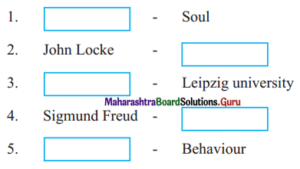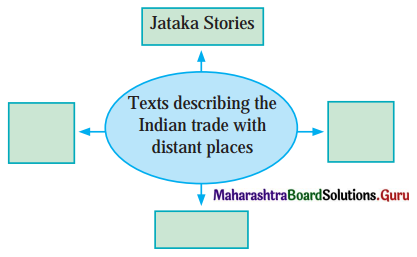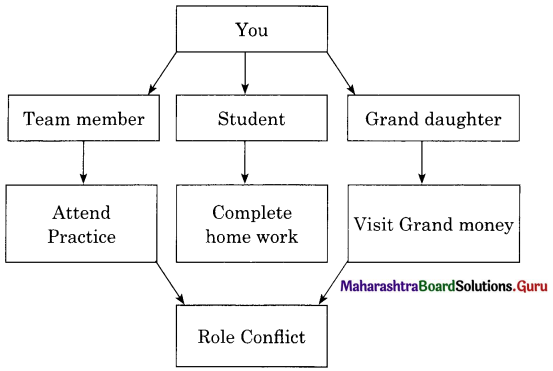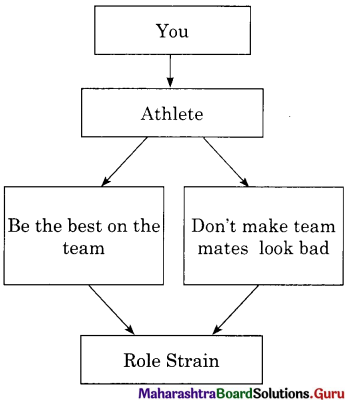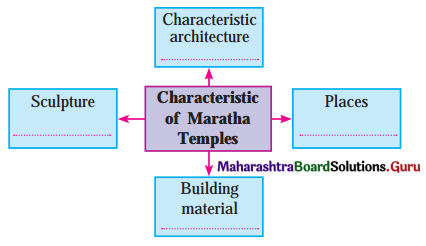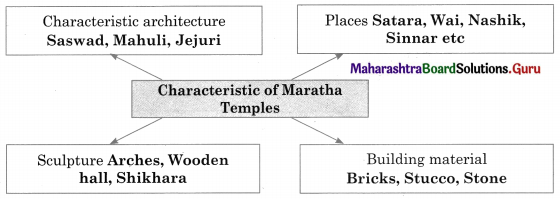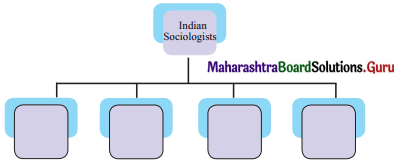Balbharti Maharashtra State Board Class 11 Sociology Solutions Chapter 4 Social Institutions Textbook Exercise Questions and Answers.
Maharashtra State Board Class 11 Sociology Solutions Chapter 4 Social Institutions
1. (A) Choose the correct alternative and complete the statements.
Question 1.
A rule that prescribes marriage within a group is called ……………….
(exogamy / endogamy / polygamy)
Answer:
endogamy
Question 2.
A family that comprises at least three generation is a ………………… family.
(nuclear / joint / cohabitation)
Answer:
joint
![]()
Question 3.
The 10 + 2 + 3 system is part of the ………………. system of education.
(informal / formal / universal)
Answer:
formal
1. (B) Correct the incorrect pair.
Question 1.
(a) School – Distance Education
(b) Peer group – Informal Education
(c) Health care training – Non-formal Education
(d) Family – Informal Education
Answer:
(a) School – Formal education
1. (C) Identify the appropriate term from the given options.
(Homosexual Marriage, Matrilocal, Heterosexual Marriage)
Question 1.
A married couple is expected to live at the wife’s residence.
Answer:
Matrilocal
Question 2.
A form of marriage between persons of the same sex.
Answer:
Homosexual Marriage
1. (D) Correct underlined words and complete the sentence.
Question 1.
X married Y. Later she divorced her spouse and married Z. This is an example of polygamy.
Answer:
X married Y. Later she divorced her spouse and married Z. This is an example of monogamy.
Question 2.
Mass production and factory system are found in agricultural society.
Answer:
Mass production and factory system are found in industrial society.
![]()
2. Write short notes.
Question 1.
Types of family based on authority.
Answer:
On the basis of authority within family, two broad forms of family can be identified. Matriarchal Family : In matriarchal family authority rests at the hands of the mother and she is considered the head of the family. In matriarchal family descent is traced through mother’s line, known as matrilineal system. Residence of the marriage is matrilocal i.e., the bridegroom lives with the wife’s family and the name follows the mother’s line. It is matronymic. The Garo and Khasi tribes of North East India and the Nair’s of South India follow the matriarchal system.
Patriarchal Family : In patriarchal family all authority rests at the hands of the male head and the eldest male is regarded as the head of the patriarchal family. It is patrilineal i.e., descent is traced through father’s line. Residence after marriage is patrilocal. The married couples live with the husband’s family, and the name of the father’s side continues to the next generation. It is patronymic. Patriarchal family is the most widespread form of family in India and most parts of the world.
![]()
Question 2.
Stages of Economy.
Answer:
Human society has evolved through various stages, depending upon the way it evolved mechanisms to adapt to changing material needs.
With respect to the changing nature of work and economy three broad stage of economy are as follows: Agriculture Revolution : From hunting-gathering and then pastoral phases, human society entered into a new stage with discovery of agriculture. With development of agriculture, food production increased. Complex division of labour, advanced trade and permanent settlement are the result of economy expansion through agricultural technology.
Industrial Revolution : Industrial revolution which happened around the middle of the 18th century, first in England transformed social and economic life like never before. It brought four notable economic changes.
- New forms of energy : With the pioneering invention of the steam engine in 1765 by James Watt, the use of animal and human muscle energy was significantly reduced.
- Centralisation of work in factories : Use of machinery gave rise to a new workplace called factory.
- Mass production : Industrial economy developed the manufacturing sector very fast and produced goods on a large scale.
- Division of labour : The factory system reduced the importance of human skills and resulted to specialised division of labour.
- Industrialization transformed the whole society and also created huge economic gaps in the society.
The Information Revolution : By the middle of the 20th century the nature of production started to change. The use of automated machinery drastically reduced the role of human labour in manufacturing. Three key changes were seen due to the development of computer and information technology.
- Tangible products to idea : The tertiary or service sector providing services and dealing with production of ideas and symbols is expanding very fast.
- Mechanical skills to literacy skills : The information revolution demands a new set of skills such as literacy skills – the ability to communicate, to write, to present and use computer technology.
- Work from anywhere : Computer technology is allowing for decentralisation of work.
Question 3.
Importance of Education.
Answer:
Education is broad process of learning that broadens an individual’s cognitive horizons and develops in them the skills to choose, evaluate and add to existing knowledge.
The functions of education can be as follows:
1. Inculcate common values and moral beliefs : Children coming from diverse family and community backgrounds gain an understanding of the common values and moral beliefs in society through school education.
2. Fosters self-discipline : Through education children learn self-discipline. They internalise the social rules that contribute to the smooth function of society.
3. Teaches specialised skills: The education system teaches specialised skills needed for a complex modern economy. For example, technical schools are specially designed to provide technical / vocational training.
4. Instils the value of achievement in children : Schools like wider society, largely operate on a meritocratic basis. Those with ability and talent achieve their just rewards.
3. Differentiate between.
Question 1.
Matriarchal Family and Patriarchal Family.
Answer:
| Matriarchal Family | Patriarchal Family |
| (i) Authority rests at the hands of the mother in a matriarchal family. She is considered the head of the family. | (i) The eldest male is regarded as the head of the patriarchal family. All authority rests at the hands of the male head. |
| (ii) Matriarchal families follow a matrilineal system of lineage i.e., descent through mother’s line. | (ii) Patriarchal family is also patrilineal i.e., descent is traced through father’s line. |
| (iii) Residence after marriage is matrilocal i.e., the bridegroom lives with the wife’s family. | (iii) Residence after marriage is patrilocal. The married couple lives with the husband’s family. |
| (iv) The name follows the mother’s line. It is matronymic. | (iv) The name of the father’s side continues to the next generation. It is patronymic. |
| (v) The Garo and Khasi tribes of North East India and the Nair’s of South India follow the matriarchal system. | (v) The most widespread form of family in India and most parts of the world is patriarchal family. |
![]()
Question 2.
Agriculture Revolution and Industrial Revolution.
Answer:
| Agriculture Revolution | Industrial Revolution |
| (i) From hunting – gathering and then pastoral phases, human society entered into a new stage with discovery of agriculture. | (i) Industrial revolution happened around the middle of the eighteenth century and transformed social and economic life. |
| (ii) Agricultures involved using technology of large -scale farming using ploughs harnessed to animals. | (ii) Industrialisation involved using of machinery and new forms of energy. |
| (iii) This increased the productive power of hunting and gathering more than tenfold. | (iii) This increased more mass production which turned raw materials into a wide range of goods. |
| (iv) griculture revolution resulted into expansion of economy through agricultural technology, complex division of labours permanent settlement and advanced trade. | (iv) Industrial revolution resulted into centralisation of work in factories and specialized division of labour. |
4. Explain the following concept with suitable examples.
Question 1.
Cohabitation
Answer:
- Cohabitation is the sharing of a household by an unmarried couple.
- Live in relations or cohabitation may or may not lead to marriage.
Example : Younger generations specially in many parts of Europe and in some urban areas in India are preferring cohabitation as family relation. This is especially true among same sex couples.
Question 2.
Formal Education
Answer:
- Formal education is planned with a specific end in view.
- It involves direct schooling and instruction. Since it is provided to fulfill specific ends, formal education is limited to a specific period. Formal education has a well-defined and systematic curriculum based on aims designed according to the needs of society.
Example : Schooling and education are considered as a formal education based on formal curriculum with specific subject and skills.
5. State whether the following statements are true or false with reasons.
Question 1.
In a modernizing society the role of parents are changing.
Answer:
This statement is True.
- Rapid growth of divorce and changing roles of woman give rise to a new family form and relation which has led to changes in the role of parents.
- The average age at which people get married is also increasing. There is also an increasing trend of individuals not getting married. There is a changing role of women due to education and employment. All these changes are affecting family as an institution.
- In our contemporary society, the traditional belief of fathers are the breadwinners and mothers only do household chores is no longer true. With the advent of globalization, their roles are changing which is vastly different from their previous generations.
![]()
Question 2.
India is in the stage of industrial revolution.
Answer:
This statement is False.
- India is in the stage of information revolution. The development of computer and information technology have changed the nature of work in India.
- The use of automated machinery has reduced the role of human labour in manufacturing. Service industries like public relations, banking and sales, media, advertising have expanded.
- The introduction of computer and information have changed the character of work in India.
6. Give your personal response.
Question 1.
What are your views about love marriage? Do you support it? Explain.
Answer:
The basic concept of love marriage lies in the fact that the girl or boy chooses his or her life partner. The restrictions of caste, religion, physical appearance does not apply when a person falls in love. In India these restrictions are seriously enforced which limit the number of desirable matches for a person. Also, it curbs the practice of dowry as one does not need to prove one’s worth. Therefore, I support love marriages.
Question 2.
How has the information revolution impacted your life?
Answer:
Information revolution has made our life easier. Information revolution has made it possible to do many things from the comforts of one’s own home. I can take virtual tour of museums, buildings etc. It has exposed one to different cultures. One can do all of shopping online. It has created abundance of data on every possible subject or interest.
7. Answer the following in detail (About 150-200 words).
Question 1.
Show how the role of family has changed in the present times. Illustrate with your own examples.
Answer:
Families are the nexus of activities that include parenting , employment and leisure. As society changes, families must adapt to the new structures and processes resulting from this change. One of the most striking features of modern societies has been rapid growth of divorce.
The average age at which people get married is also increasing along with an increasing trend of an individuals not getting married. The changing roles of woman through increased education and employment, has put additional pressures on the family to adapt to dual-earner, households and changing needs of child care. All these changes are affecting family as an institution.
It has given rise to new family relationship:
(i) Single-parent Family : Majority of single parent families are headed by single mothers. This may result from divorce, separation, death or by choice. Sometimes growing up in a single parent family can be a disadvantage for children.
(ii) Cohabitation : Cohabitation is the sharing of a household by an unmarried couple. Younger generations, especially in many parts of Europe and in some urban areas in India are preferring cohabitation as family relation. This is especially true among some same sex couples.
(iii) Step-parenting : As rates of divorce and remarriage is steadily on an increase, it gives rise to a new family form and relation of step-parenting. The extent of children staying in step families is increasing.
In the traditional family living, the wife had no voice in family decision making but in contemporary family she has equal power role to play. The authority has shifted from patriarchal to parents who consult their children an all-important issues before taking any decisions about them. Younger generations now claim more individuality. Change in family does not mean the complete erosion of previous norms and structure.
![]()
11th Sociology Digest Chapter 4 Social Institutions Intext Questions and Answers
ACTIVITY (Textbook Page No. 41)
Question 1.
Discuss why hypogamous marriages are resisted in society. Take help of newspapers, magazines and cinema.
Answer:
Reasons for resisting hypogamous marriage. Hypergamy is a term used for the practice of a person marrying a spouse of higher caste or social status than themselves. Young women generally marry older men of higher status, with general rule that older men have more time to create wealth and status than younger men. Today such marriages are on decline, as most people marry their approximate social equals and in some parts of the world hypergamy has decreased. Also, it is becoming less common for women to marry older men though hypergamy does not require the man to be older but only of higher status.
Question 2.
Look at the matrimonial advertisements in newspapers, magazines and internet and discuss the findings. Do you think endogamy is still the prevalent norm in India? (Textbook Page No. 42)
Answer:
Religion and Caste endogamy still dominates while choosing a life partner. Women have the freedom to select a spouse in urban areas, yet, the choice can be restricted. So, in general, marriage is often seen as socially determined institutions.
Question 3.
Watch the classic movie ‘Modern Times’ made by Charlie Chaplin and have a discussion on the effects of mechanisation on human labour. (Textbook Page No. 44)
Answer:
The film ‘Modern Times’ is a comment on the desperate employment and financial conditions that people faced during the great depression conditions created, by the modern industrialization in the view of Chaplin. Modern Times’ portray Chaplin as a factory worker where he is subjected to such indignities as being forced fed by a malfunctioning ‘feeding machine’. In the movie, industry is portrayed as something bigger and more valuable than the people who work within it. Chaplin tries to point out the fact at the industrialized world functions in a way that suppresses human agency and creativity.
![]()
Question 4.
Eminent personalities having achieved social prestige and position on the basis of their educational qualification. (Textbook Page No. 48)
Answer:
(i) Bhimrao Ramji Ambedkar : Dr. Bhimrao Ambedkar was born on 14th April 1891. During his childhood he was subjected to socio-economic discrimination and faced severe humiliation. Dr. Ambedkar earned his doctorates in Economics from both Columbia University and the London School of Economics. He gained reputation as a scholar for his research in Law, economics and political science. In his initial career, he worked as an economist, professor and lawyer. He was posthumous awarded the Bharat Ratna, India’s highest civilian award, in 1990.
(ii) A. P. J. Abdul Kalam : A. P. J. Abdul Kalam was born on 15th October 1931. His father was an owner of a boat, an imam of local mosque. Due to destruction in business and loss of the family fortune, Kalam’s family suffered poverty. To help his family, he started selling newspapers at an early age. Abdul Kalam completed his graduation from the Madras Institute of Technology and joined the Aeronautical Development Establishment of the Defence Research and Development Organisation (DRDO) as a scientist after becoming a member of Defence Research and Development Service (DRDS). He came to be known as the Missile Man of India’. He was the 11th President of India.
